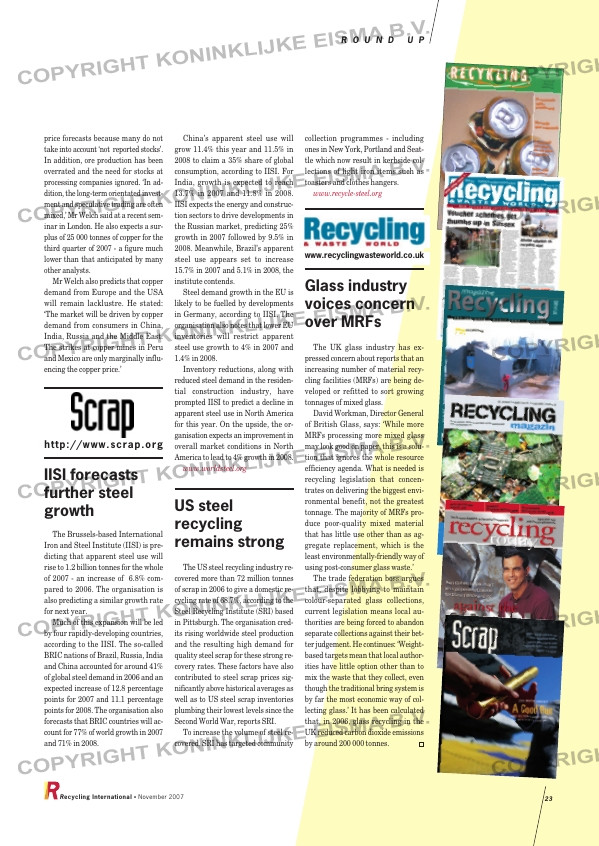Page 23 from: November 2007

price forecasts because many do not
take into account ‘not reported stocks’.
In addition, ore production has been
overrated and the need for stocks at
processing companies ignored. ‘In ad-
dition, the long-term orientated invest-
ment and speculative trading are often
mixed,’ Mr Welch said at a recent sem-
inar in London. He also expects a sur-
plus of 25 000 tonnes of copper for the
third quarter of 2007 – a figure much
lower than that anticipated by many
other analysts.
Mr Welch also predicts that copper
demand from Europe and the USA
will remain lacklustre. He stated:
‘The market will be driven by copper
demand from consumers in China,
India, Russia and the Middle East.
The strikes at copper mines in Peru
and Mexico are only marginally influ-
encing the copper price.’
IISI forecasts
further steel
growth
The Brussels-based International
Iron and Steel Institute (IISI) is pre-
dicting that apparent steel use will
rise to 1.2 billion tonnes for the whole
of 2007 – an increase of 6.8% com-
pared to 2006. The organisation is
also predicting a similar growth rate
for next year.
Much of this expansion will be led
by four rapidly-developing countries,
according to the IISI. The so-called
BRIC nations of Brazil, Russia, India
and China accounted for around 41%
of global steel demand in 2006 and an
expected increase of 12.8 percentage
points for 2007 and 11.1 percentage
points for 2008. The organisation also
forecasts that BRIC countries will ac-
count for 77% of world growth in 2007
and 71% in 2008.
China’s apparent steel use will
grow 11.4% this year and 11.5% in
2008 to claim a 35% share of global
consumption, according to IISI. For
India, growth is expected to reach
13.7% in 2007 and 11.8% in 2008.
IISI expects the energy and construc-
tion sectors to drive developments in
the Russian market, predicting 25%
growth in 2007 followed by 9.5% in
2008. Meanwhile, Brazil’s apparent
steel use appears set to increase
15.7% in 2007 and 5.1% in 2008, the
institute contends.
Steel demand growth in the EU is
likely to be fuelled by developments
in Germany, according to IISI. The
organisation also notes that lower EU
inventories will restrict apparent
steel use growth to 4% in 2007 and
1.4% in 2008.
Inventory reductions, along with
reduced steel demand in the residen-
tial construction industry, have
prompted IISI to predict a decline in
apparent steel use in North America
for this year. On the upside, the or-
ganisation expects an improvement in
overall market conditions in North
America to lead to 4% growth in 2008.
www.worldsteel.org
US steel
recycling
remains strong
The US steel recycling industry re-
covered more than 72 million tonnes
of scrap in 2006 to give a domestic re-
cycling rate of 68.7%, according to the
Steel Recycling Institute (SRI) based
in Pittsburgh. The organisation cred-
its rising worldwide steel production
and the resulting high demand for
quality steel scrap for these strong re-
covery rates. These factors have also
contributed to steel scrap prices sig-
nificantly above historical averages as
well as to US steel scrap inventories
plumbing their lowest levels since the
Second World War, reports SRI.
To increase the volume of steel re-
covered, SRI has targeted community
https://www.scrap.org
R O U N D U P
collection programmes – including
ones in New York, Portland and Seat-
tle which now result in kerbside col-
lections of light iron items such as
toasters and clothes hangers.
www.recycle-steel.org
Glass industry
voices concern
over MRFs
The UK glass industry has ex-
pressed concern about reports that an
increasing number of material recy-
cling facilities (MRFs) are being de-
veloped or refitted to sort growing
tonnages of mixed glass.
David Workman, Director General
of British Glass, says: ‘While more
MRFs processing more mixed glass
may look good on paper, this is a solu-
tion that ignores the whole resource
efficiency agenda. What is needed is
recycling legislation that concen-
trates on delivering the biggest envi-
ronmental benefit, not the greatest
tonnage. The majority of MRFs pro-
duce poor-quality mixed material
that has little use other than as ag-
gregate replacement, which is the
least environmentally-friendly way of
using post-consumer glass waste.’
The trade federation boss argues
that, despite lobbying to maintain
colour-separated glass collections,
current legislation means local au-
thorities are being forced to abandon
separate collections against their bet-
ter judgement. He continues: ‘Weight-
based targets mean that local author-
ities have little option other than to
mix the waste that they collect, even
though the traditional bring system is
by far the most economic way of col-
lecting glass.’ It has been calculated
that, in 2006, glass recycling in the
UK reduced carbon dioxide emissions
by around 200 000 tonnes.
www.recy cling wasteworld.co.uk
Recycling International • November 2007 23
RI_033 Round Up:Round Up 08-11-2007 09:15 Pagina 23



